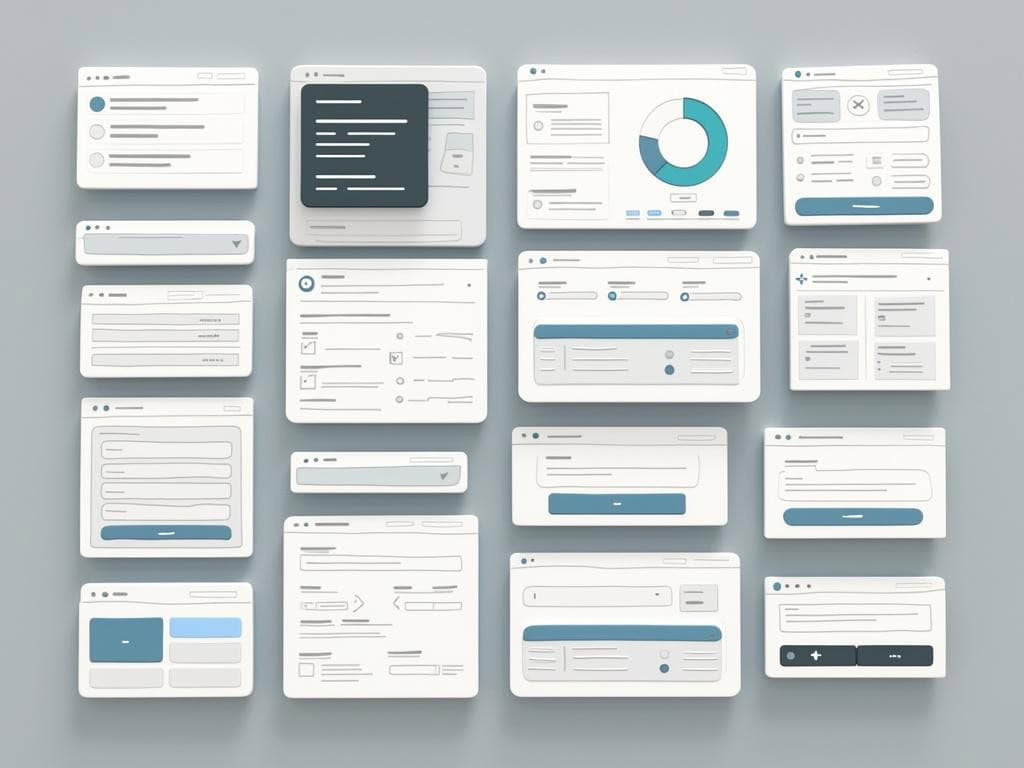
Competitive and Comparative Analysis in UX
Competitive and comparative analysis UX evaluates competitors’ products and user experiences to benchmark performance and identify improvement opportunities. This strategic research method examines design elements, interaction patterns, and usability factors, giving you valuable insights into market positioning and potential gaps to address.
Key Takeaways:
- Provides a comprehensive understanding of market standards and competitive landscape
- Helps identify unique opportunities for product differentiation and innovation
- Enables data-driven decision-making in product development and user experience design
- Supports resource allocation by revealing competitor strengths and weaknesses
- Facilitates continuous improvement through ongoing competitive intelligence gathering
Conducting thorough competitive analysis gives you an edge in today’s crowded digital marketplace. Start by identifying your direct and indirect competitors through market research tools that track industry trends. Create a structured framework to compare key aspects across platforms.
Focus your analysis on user flows, information architecture, and visual design elements. Document both positive and negative aspects of each competitor’s approach. This practical comparison helps you spot gaps in the market while avoiding common pitfalls.
Effective UX competitive analysis requires both quantitative metrics and qualitative assessments. Track conversion rates, engagement statistics, and user satisfaction scores alongside subjective evaluations of design coherence and brand consistency. The Nielsen Norman Group offers excellent guidelines for structuring your comparative framework.
The insights gained from this process directly inform your product strategy and design decisions. You’ll identify which features users expect as standard and where you can create distinctive experiences. This balanced approach ensures your product meets basic user needs while offering unique advantages.
Maintain regular competitive monitoring schedules to stay current with industry shifts. Digital products change rapidly, so quarterly reviews help you track emerging patterns and adjust your strategy accordingly. Consider using specialized user testing services to gather unbiased feedback about your position relative to competitors.
“Competitive and comparative analysis in UX not only illuminates the competitive landscape but also empowers businesses to transform insights into innovation. By leveraging these strategic evaluations, companies can carve out unique opportunities for differentiation and drive data-driven decisions that enhance user experience.”
Defining Competitive Analysis in UX
Competitive and comparative analysis in UX is a strategic research method that evaluates your competitors’ products and user experiences. This analysis focuses on design elements, interaction patterns, usability factors, and business considerations that impact the overall user experience. You’ll gain valuable insights to benchmark your product against industry standards and identify opportunities for improvement.
When conducting competitive and comparative analysis UX, you’re examining multiple dimensions of user experience across competing products. This approach helps you understand where your product stands in relation to others and reveals potential market gaps you can exploit.
Key Components of UX Competitive Analysis
Effective competitive and comparative analysis UX involves several crucial elements that work together to provide a comprehensive assessment:
- Design assessment – Evaluate visual aesthetics, information architecture, and navigation patterns
- Feature comparison – Identify core and unique functionalities across competing products
- User flow analysis – Map user journeys through critical tasks and interactions
- Usability evaluation – Assess how efficiently users can accomplish tasks with competing products
- Value proposition review – Determine how competitors position their unique benefits
You can strengthen your strategic planning efforts through competitive analysis by regularly monitoring how competitors evolve their UX. This approach requires systematic data collection using both qualitative and quantitative methods.
The competitive and comparative analysis UX process reveals patterns across products that help you understand industry trends. By analyzing these patterns, you’ll recognize which features and experiences users expect as standard and which innovative elements might differentiate your product.
Your competitive analysis should include both direct competitors offering similar solutions and indirect competitors solving the same problems through different approaches. This comprehensive view helps you develop a more robust UX strategy that addresses market needs effectively.
Implementing insights from competitive and comparative analysis UX requires collaboration between design, development, and business teams. When these groups work together to interpret findings, you can create collaborative project solutions that address both user needs and business goals.
The competitive landscape constantly evolves, making competitive and comparative analysis UX an ongoing process rather than a one-time effort. You’ll need to regularly reassess competitors to maintain awareness of emerging trends and changing user expectations.

Strategic Benefits for Business Leaders
Competitive and comparative analysis UX provides comprehensive market positioning insights that can transform your product strategy. This analytical approach enables you to make data-driven decisions throughout your product development lifecycle, replacing guesswork with evidence-based direction. According to a Nielsen Norman Group survey, 61% of UX professionals prioritize competitive analysis as a core research method, highlighting its critical importance in modern business strategy.
By conducting thorough competitive and comparative analysis UX, you’ll identify unserved or underserved user needs that represent significant market opportunities. This intelligence allows you to perform competitive analysis that pinpoints exactly where your product can excel against competitors. You’ll gain objective assessment of your product’s strengths and weaknesses, creating a roadmap for strategic improvements.
Key Business Advantages of UX Competitive Analysis
Implementing competitive and comparative analysis UX delivers several concrete benefits for your organization:
- Reduces development risks by validating concepts against market realities
- Reveals competitor blind spots you can exploit with your product design
- Supports more accurate resource allocation based on competitive priorities
- Strengthens stakeholder alignment through shared competitive intelligence
- Accelerates innovation by building on proven UX patterns
Competitive and comparative analysis UX helps you avoid costly mistakes by learning from competitors’ successes and failures. This approach is particularly valuable when planning strategic initiatives as it provides context for your decision-making. The insights gained allow you to position your product uniquely while addressing genuine user needs.
Your competitive analysis findings create a foundation for strategic differentiation. This table illustrates how different competitive positions translate to business outcomes:
| Competitive Position | Strategic Focus | Business Impact |
|---|---|---|
| Industry Leader | Innovation | Premium pricing, market share dominance |
| Fast Follower | Refinement | Cost efficiencies, rapid adoption |
| Niche Specialist | Customization | Higher loyalty, targeted audience growth |
| Disruptor | Reimagination | New market creation, category definition |
Through systematic competitive and comparative analysis UX, you’ll develop a deeper understanding of user expectations and how they’re currently being met or missed in your market. This intelligence becomes invaluable when making strategic decisions about product direction, feature prioritization, and experience design.

Comprehensive Analysis Methodology
Your competitive and comparative analysis UX approach needs a structured methodology to yield actionable insights. A thorough competitive and comparative analysis UX framework helps you identify market gaps and establish benchmarks against industry standards.
Begin by defining clear research objectives for your competitive and comparative analysis UX study. Your goals might include discovering feature gaps, identifying usability issues, or understanding competitors’ value propositions. Without defined goals, your competitive and comparative analysis UX efforts may lack focus.
Selecting the right competitors forms a crucial step in effective competitive and comparative analysis UX. Create a balanced competitor set including:
- Direct competitors offering similar products
- Indirect competitors solving the same problems differently
- Aspirational brands setting UX standards in other industries
Next, conduct an honest internal audit of your product’s UX before analyzing competitors. This provides a baseline for your competitive and comparative analysis UX work and helps you evaluate competitors objectively against your own strengths and weaknesses.
The data collection phase requires both quantitative and qualitative approaches. Your competitive and comparative analysis UX should incorporate:
- Heuristic evaluations using established UX principles
- Usability testing with real users across competitor products
- Feature comparison matrices documenting functionality differences
- User journey mapping to understand different experience flows
For advanced competitive and comparative analysis UX research, consider implementing specialized tools like UXtweak, UXPin, or Maze. These platforms provide structured frameworks for analyzing multiple products and generating actionable strategic insights from your findings.
Expert Review Techniques
Expert review methods form the backbone of effective competitive and comparative analysis UX. Heuristic evaluation allows experienced UX professionals to assess products against established usability principles. When conducting competitive and comparative analysis UX reviews, evaluate competitors against Jakob Nielsen’s 10 usability heuristics or similar frameworks.
Create a competitive and comparative analysis UX scorecard to systematize your evaluation. This approach lets you quantify subjective assessments and track improvements over time. Your scorecard might include:
| Evaluation Area | Your Product | Competitor A | Competitor B |
|---|---|---|---|
| Navigation | 3/5 | 4/5 | 2/5 |
| Content | 4/5 | 3/5 | 5/5 |
| Visual Design | 3/5 | 5/5 | 3/5 |
| Accessibility | 2/5 | 3/5 | 4/5 |
| Performance | 4/5 | 2/5 | 3/5 |
Competitive usability testing represents another powerful competitive and comparative analysis UX technique. This involves recruiting users to complete identical tasks across different products and measuring performance metrics. According to Nielsen Norman Group’s research, 61% of UX professionals prioritize competitive analysis for strategic decision-making.
Your competitive and comparative analysis UX process should culminate in actionable recommendations. Transform insights into specific improvement opportunities, feature prioritization strategies, and competitive response strategies that address identified gaps in the user experience.

Competitive Insights and Innovation Drivers
Tracking emerging UX patterns is vital when performing competitive and comparative analysis UX for your business. You’ll gain critical intelligence about your market position while identifying opportunities to leapfrog competitors. Competitive and comparative analysis UX helps you spot gaps where your product can excel and discover what resonates with users across your industry.
According to the Nielsen Norman Group survey, 61% of UX professionals prioritize competitive analysis in their workflow. This approach isn’t just about keeping pace—it’s about strategically positioning your product for maximum impact and user satisfaction.
Feature Prioritization Through Competitive Intelligence
Competitive and comparative analysis UX provides essential data points to inform your feature development roadmap. Here’s how you can leverage competitive insights:
- Identify feature gaps that represent market opportunities
- Evaluate which competitor features drive the highest engagement
- Assess which UX patterns are becoming industry standards
- Determine where your product can establish unique differentiation
- Analyze conversion points where competitors excel or struggle
A well-executed competitive and comparative analysis UX process helps you develop stronger strategic planning by focusing on what matters most to users. When you discover that competitors have implemented personalized support features with positive outcomes, you can adapt similar approaches while improving upon their execution.
The competitive analysis table below shows how to organize your findings effectively:
| Competitor | Key UX Strengths | Notable Weaknesses | Innovation Opportunities |
|---|---|---|---|
| Competitor A | Intuitive navigation, Fast load times | Limited personalization, Poor mobile experience | Enhanced mobile interface with personalization |
| Competitor B | Strong visual hierarchy, Effective onboarding | Complex checkout, Limited accessibility | Streamlined conversion paths with accessibility focus |
| Competitor C | Excellent search functionality, Robust filters | Cluttered interface, Inconsistent design patterns | Clean, consistent design system with advanced search |
By systematically tracking competitive insights, you can make informed decisions about where to invest your UX resources. This approach ensures your project stakeholders understand the strategic rationale behind design choices and feature priorities.
Competitive and comparative analysis UX should become an ongoing practice rather than a one-time effort. Regular monitoring allows you to stay ahead of market shifts and continuously refine your approach to meet evolving user expectations. Through diligent competitive analysis, you’ll develop a deeper understanding of both your users and the competitive landscape, driving innovation that truly matters.
70% of companies with structured competitive analysis reports improved their overall strategy and market positioning, which significantly boosts customer satisfaction.
hbr.org
Visual and Interaction Design Assessment
Your competitive and comparative analysis UX needs to thoroughly examine how competitors design their visual interfaces and user interactions. This critical assessment reveals valuable insights about market trends and user expectations that can elevate your design strategy.
When conducting a competitive and comparative analysis UX evaluation, focus on both aesthetic and functional elements that shape the user experience. You’ll need to analyze how competitors implement features and determine if these implementations effectively meet user needs.
Begin by mapping out user flows across competitive products to identify where competitors excel or fall short. Document the steps required to complete key tasks, comparing complexity and intuitiveness. This competitive and comparative analysis UX process helps you spot opportunities for streamlining your own user journeys.
Consider these essential aspects during your assessment:
- Color schemes and brand consistency across platforms
- Typography choices and their impact on readability
- Navigation patterns and information architecture
- Interactive elements (buttons, forms, menus) and their responsiveness
- Micro-interactions and animation effects
- Content organization and hierarchy
- Visual feedback mechanisms
- Accessibility features and compliance standards
Evaluating Interaction Quality
The quality of interactions significantly impacts user satisfaction and task completion rates. Your competitive and comparative analysis UX should evaluate how competitors handle these crucial touchpoints.
Review how competitors manage these interaction aspects:
- Responsiveness to user inputs
- Error prevention and recovery mechanisms
- System feedback clarity and timeliness
- Consistency across different device types
- Loading states and transition animations
- Form validation approaches
- Search functionality effectiveness
- Filter and sort capabilities
The table below summarizes key dimensions to consider in your competitive and comparative analysis UX assessment:
| Assessment Area | Evaluation Factors | Business Impact |
|---|---|---|
| Visual Design | Color, typography, imagery, layout | Brand perception, emotional response |
| Navigation | Menu structure, wayfinding, breadcrumbs | Findability, user confidence |
| Interaction Design | Buttons, forms, scrolling behavior | Task completion, user satisfaction |
| Feedback | Loading indicators, error messages, confirmations | User trust, support costs |
| Accessibility | Color contrast, keyboard navigation, screen reader support | Market reach, legal compliance |
By systematically evaluating these elements through competitive and comparative analysis UX research, you’ll identify specific design improvements that can enhance your strategic planning for product development. These insights enable you to make informed design decisions rather than simply copying competitors.
Regular competitive and comparative analysis UX assessments help you maintain continuous improvement in your design approach while establishing a distinctive user experience that addresses genuine user needs.
Implementing Competitive Analysis: Practical Applications
You’ll gain the most value from competitive and comparative analysis UX when you transform research insights into concrete product improvements. This crucial process bridges the gap between theoretical knowledge and practical application, helping you develop a genuine competitive edge in your marketplace.
Start by mapping all identified competitor strengths and weaknesses against your own product experience. This direct competitive and comparative analysis UX exercise helps you pinpoint specific areas where your product lags behind or leads the market. Create a prioritized improvement roadmap based on these findings, focusing on high-impact changes that align with your business objectives.
User experience improvements should be implemented systematically, not haphazardly. Consider these essential implementation strategies:
- Enhance existing features before adding new ones
- Address critical usability issues identified during competitor analysis
- Adopt successful competitor design patterns while maintaining brand identity
- Prioritize improvements based on user impact and implementation complexity
- Continuously test changes with actual users to validate effectiveness
Involve cross-functional teams when performing competitive analysis to ensure all perspectives are considered. Product managers, designers, developers, and marketing stakeholders each bring valuable insights that strengthen your competitive position.
Creating Sustainable Competitive Advantage
The most effective competitive and comparative analysis UX goes beyond one-time implementations. You need to establish a continuous improvement cycle that responds to market changes. Develop a system for regular competitive monitoring that includes:
- Quarterly comprehensive competitive analysis reviews
- Monthly feature release tracking for key competitors
- User feedback collection specifically comparing your product to alternatives
- Performance metric tracking against industry benchmarks
This ongoing approach ensures you’re not simply catching up to competitors but actively working on a project to surpass them. By combining competitor insights with your unique value proposition, you’ll create experiences that truly differentiate your product.
Remember that competitive and comparative analysis UX should inspire innovation, not just imitation. The goal isn’t to copy competitors but to understand market expectations and then exceed them in ways that align with your brand and business strategy.






